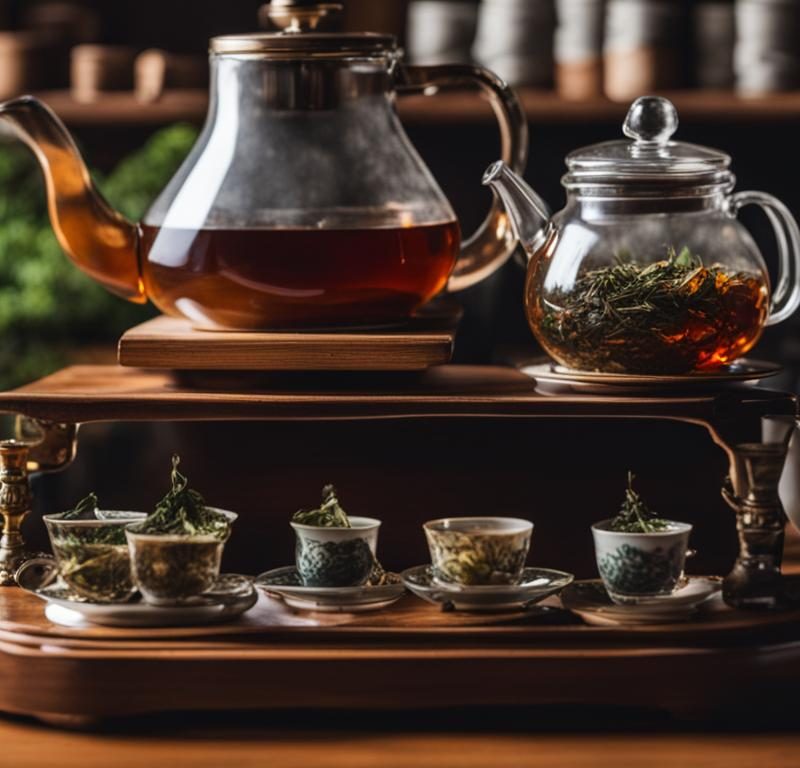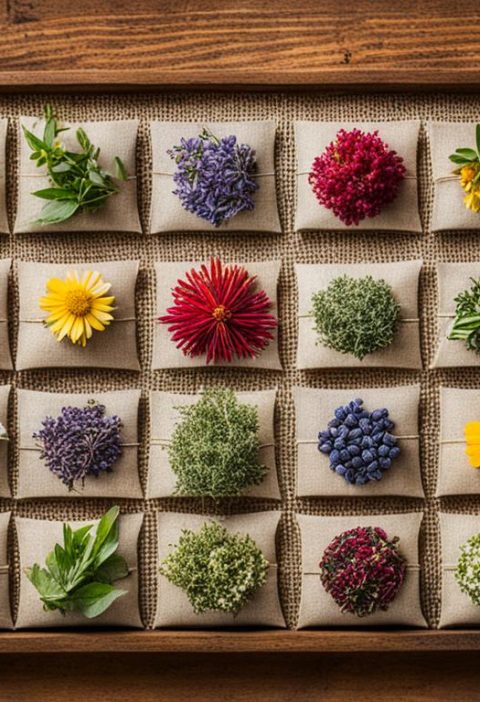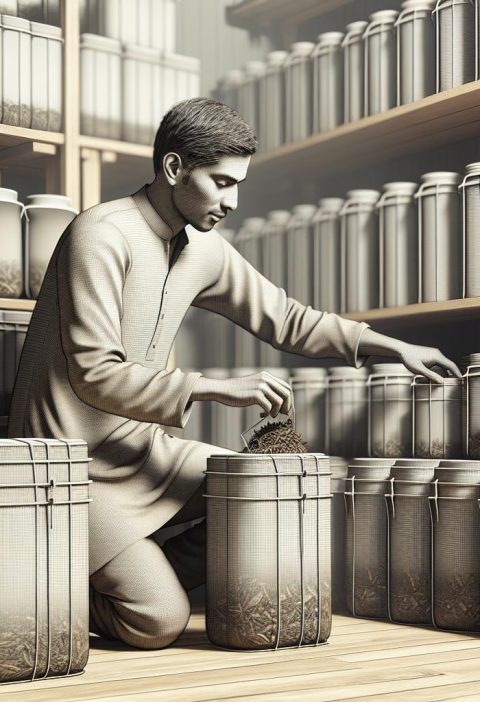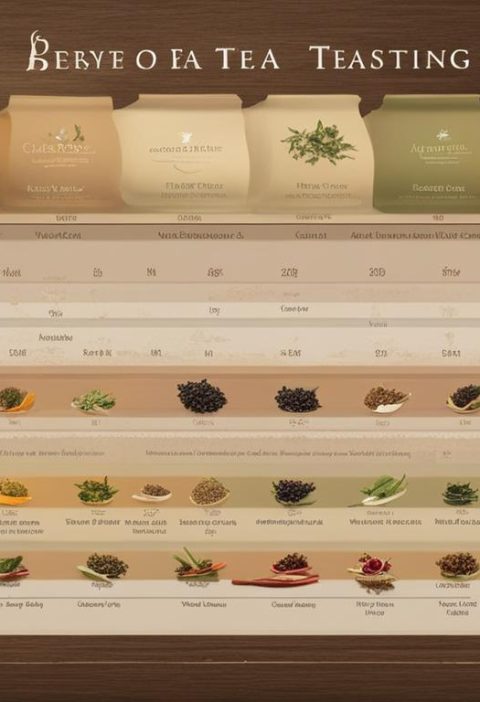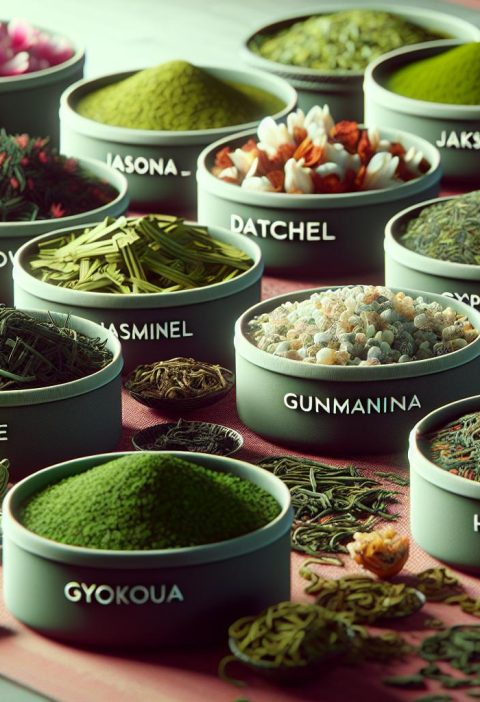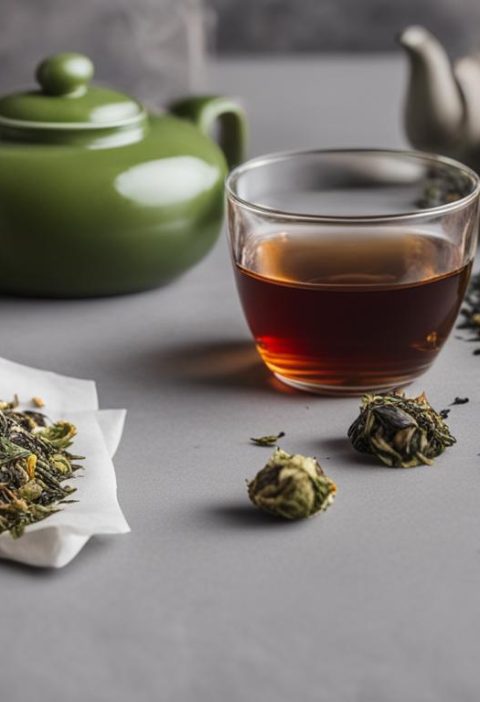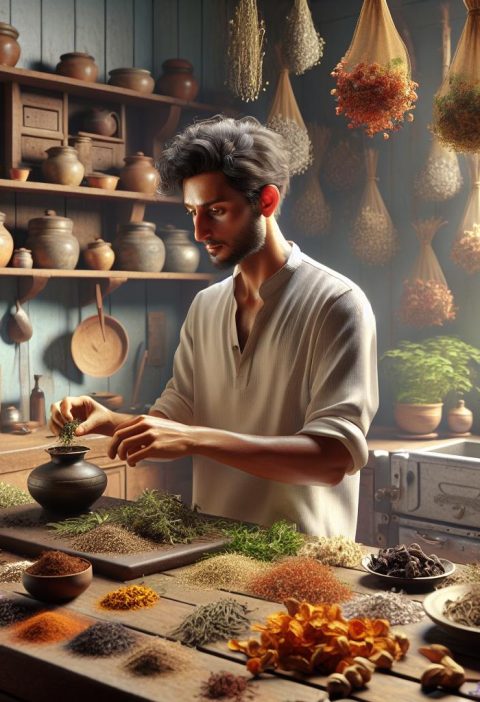When it comes to brewing the perfect cup of tea, there are several advanced steeping methods that tea enthusiasts can use to enhance their tea experience. These methods have been studied and practiced over centuries, offering a variety of techniques to bring out the best flavors and aromas in loose leaf teas. In this guide, we will explore five popular tea brewing methods: Gong Fu Cha, Western Style, Grandpa Style, Boiling, and Cold Brew Tea.
Key Takeaways:
- Advanced steeping methods can elevate your tea steeping game and help you master tea steeping techniques.
- Gong Fu Cha, a traditional Chinese tea ceremony, allows tea leaves to be re-steeped over ten times.
- Western Style brewing, using a large teapot, is convenient and results in an aromatic and flavorful brew.
- Grandpa Style is a quick and simple tea brewing method that requires no strainers or teabags.
- Boiling tea can create intense flavors but is not suitable for all types of teas.
- Cold Brew Tea offers a refreshing and less caffeinated option, perfect for hot summer days.
Gong Fu Cha
Gong Fu Cha, which translates to “making tea with skill,” is a traditional Chinese tea ceremony that involves steeping concentrated amounts of tea leaves in small vessels for short periods of time. This method allows the same tea leaves to be re-steeped over ten times, creating a unique and evolving flavor profile with each brew. Gong Fu Cha is considered an art form in Chinese tea culture and is often practiced by tea masters. It offers a slow and meditative experience, allowing tea enthusiasts to discover new tastes and aromas with each infusion.
The Gong Fu Brewing Method
During a Gong Fu Cha ceremony, the brewing process is carefully executed to bring out the full potential of the tea leaves. Here are the essential steps:
- 1. Warm the teaware: Pre-heat the teapot, tea cups, and pitcher by rinsing them with hot water to ensure optimal brewing temperature.
- 2. Measure the tea leaves: Use a scale or visually estimate the amount of tea leaves needed, depending on the size of the teapot and personal preference.
- 3. Rinse the tea leaves: Pour hot water over the tea leaves in the teapot, then quickly pour it out to awaken the leaves and remove any impurities.
- 4. Steep the tea: Steep the tea leaves in the teapot for a short duration, typically starting with a few seconds and gradually increasing the steeping time with each subsequent infusion. This gradual increase in steeping time allows the flavors to develop and intensify over multiple brews.
- 5. Serve and enjoy: Pour the brewed tea into small cups, allowing each participant to savor the aroma and taste of the tea. Take your time to appreciate the complexities and nuances of each cup.
Gong Fu Cha is characterized by the use of small teapots, often made of clay or porcelain, to create concentrated infusions of tea. The small vessels allow for a higher tea-to-water ratio, resulting in a deeper flavor and aroma. The repeated steeping of tea leaves brings out different flavor notes and aromas with each infusion, making every cup a new experience.
Gong Fu Cha Tea List
| Tea Type | Flavor Profile | Recommended Steeping Time |
|---|---|---|
| Wuyi Rock oolong | Roasted, mineral, fruity | 25 seconds |
| Pu-erh | Earthy, woody, aged | 20 seconds |
| Tie Guan Yin | Floral, creamy, buttery | 15 seconds |
| Long Jing (Dragon Well) | Grassy, chestnut, fresh | 10 seconds |
| Da Hong Pao | Smoky, rich, complex | 30 seconds |
Each type of tea has its own unique flavor profile and recommended steeping time. Experimentation with different teas and steeping parameters is encouraged to find the perfect balance of flavors and aromas.
Western Style
The Western Style of tea brewing is a simple and convenient method that involves using a large teapot to steep tea leaves for an extended period of time. Unlike the intricate tools used in Gong Fu Cha, this method requires only one teapot, making it popular in cafes and households.
When brewing tea in the Western Style, a larger teapot is used, allowing the tea leaves to expand naturally and infuse the water with their flavors and aromas. This results in a more aromatic and flavorful brew compared to tea bags, which often contain tea dust or fannings.
In Western Style brewing, loose tea leaves are placed directly in the teapot, allowing them to steep and infuse the hot water with their rich flavors. The longer steeping time in a larger vessel creates a stronger and more robust brew, perfect for those who prefer a bolder cup of tea.
One of the advantages of brewing tea in the Western Style is the ability to experiment with different flavors and blends. The larger teapot allows for the use of a variety of tea leaves, including blends with herbs, flowers, or fruit infusions, resulting in a wide range of aromatic and flavorful brews.
Whether you prefer a traditional black tea, a fragrant Earl Grey, or a refreshing herbal blend, the Western Style brewing method offers a convenient and versatile way to enjoy a flavorful cup of tea. It is widely practiced in the West and has become a beloved method for tea enthusiasts who appreciate a quick and easy way to brew their favorite tea.
So why not elevate your tea experience with the Western Style brewing method? Explore the world of loose leaf teas, invest in a large teapot, and savor the aromatic and flavorful brew that this brewing technique has to offer.
Recommended Tea Accessories for Western Style Brewing
- A large teapot with a removable infuser
- High-quality loose leaf teas
- A tea scale or spoon for measuring the right amount of tea
- A tea timer or watch to keep track of the steeping time
- Teacups or mugs to enjoy your aromatic and flavorful brew
Grandpa Style
Grandpa Style is a unique tea brewing method that originated from the preference of older citizens in China to enjoy tea while relaxing or chatting with friends. In this method, tea leaves are put directly into a big cup without the use of any strainers or teabags. The leaves are covered with hot water and left to steep for 5 to 15 minutes, depending on personal preference. As the tea is drunk, more hot water is added until the taste becomes weak or the tea drinker is satisfied. Grandpa Style is a popular choice for tea enthusiasts on the go or those who want a quick and simple tea brewing experience without the need for special teaware or precise measurements.
The Process of Grandpa Style:
- Select a big cup or mug.
- Add tea leaves directly into the cup. The amount of leaves can vary based on personal taste.
- Pour hot water over the leaves, fully covering them.
- Let the tea steep for 5 to 15 minutes, depending on desired strength.
- Sip the tea, and as it is consumed, add more hot water to maintain the desired flavor.
- Repeat the process until the taste becomes weak or the tea drinker is satisfied.
Grandpa Style offers a convenient and fuss-free way to enjoy tea, especially for those who appreciate a more casual tea-drinking experience. The simplicity of this method allows tea enthusiasts to focus on the flavors and aromas of the tea leaves without the need for strainers or teabags. It is an excellent option for tea lovers who prefer a quick and direct approach to brewing tea, as well as for those who are always on the move.
To enhance your understanding of Grandpa Style, refer to the table below, which summarizes the key characteristics and benefits of this brewing method:
| Characteristics | Benefits |
|---|---|
| No strainers or teabags | Allows for a more intimate connection with the tea leaves and their flavors. |
| Direct steeping in a big cup | Simplifies the brewing process and eliminates the need for additional teaware. |
| Flexible steeping time | Enables personalization of tea strength according to individual preference. |
| Adaptable to various tea types | Can be used with a wide range of tea varieties, allowing for exploration and experimentation. |
Grandpa Style is a testament to the versatility and adaptability of tea brewing methods. Its simple yet effective approach offers a delightful and unpretentious way to enjoy the beauty of tea. Whether you’re a seasoned tea enthusiast or just starting to explore the world of tea, Grandpa Style is definitely worth a try.
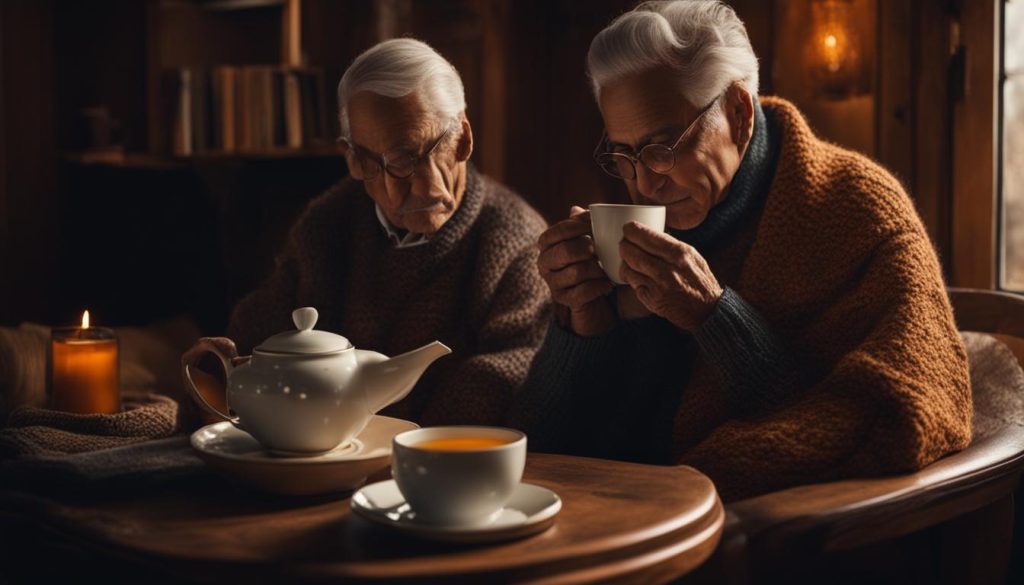
Boiling
Boiling tea leaves is a time-honored tradition that dates back to the Tang Dynasty in China. During this ancient period, tea lovers would boil tea leaves for prolonged periods, infusing them with various herbs, spices, roots, and even fruits to create intense and flavorful brews. While not suitable for all types of tea, boiling is particularly enjoyed with pu-erh, hei cha, certain oolongs, and aged white teas.
Boiling tea not only extracts the robust flavors from the leaves but also offers a longer tea-drinking experience. The process of simmering the tea for an extended time allows the flavors to develop slowly and intensify. This results in a rich and concentrated brew that captivates the senses.
The boiling method was favored during ancient times for its ability to extract the full potential of the tea leaves and create a satisfying beverage. However, it is important to note that boiling is not suitable for all types of tea. Green and black teas, for example, tend to become excessively astringent and lose their delicate flavors when subjected to boiling temperatures.
Despite this limitation, boiling tea is still practiced today for its historical significance and the exceptional flavors it can produce with certain types of tea. It offers a unique and immersive tea experience that connects modern tea enthusiasts with the ancient roots of tea culture.
Cold Brew Tea
When it comes to a refreshing and less stimulating tea experience, Cold Brew Tea is the perfect choice. This method involves pouring cold water over tea leaves and steeping them in the fridge for several hours. While it requires patience, the resulting brew is known for its sweet and flavorful taste. Additionally, cold brewing leads to a lower caffeine content compared to hot brewing methods.
Cold Brew Tea is particularly popular during hot summer days, offering a cool and refreshing option to quench your thirst. Japanese teas, in particular, are favored for cold brews due to their delicate flavors. The longer steeping time allows the tea leaves to slowly release their flavors, resulting in a smooth and satisfying brew.
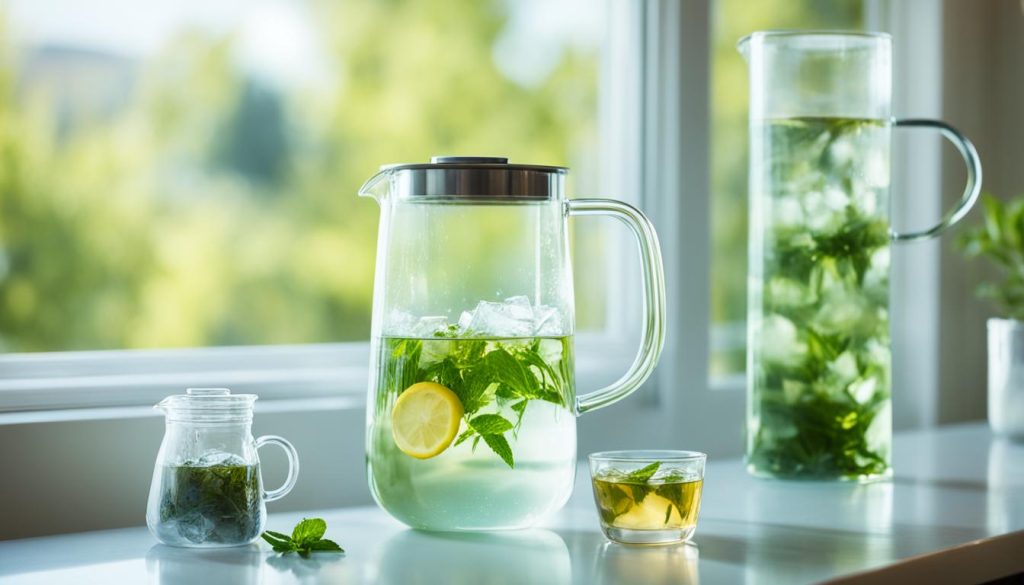
Cold brewing offers a simple and convenient way to enjoy tea without the need for hot water or heating appliances. It also provides the opportunity to explore a wide range of flavors as different tea varieties can be cold brewed. Whether you prefer black, green, white, or herbal tea, the cold brew method brings out the best in each type.
How to Prepare Cold Brew Tea
To prepare Cold Brew Tea, follow these simple steps:
- Choose your favorite loose leaf tea or tea bags. Ensure they are of high quality for the best flavor.
- Measure the desired amount of tea leaves or tea bags. As a general guideline, use approximately 1 tablespoon of tea leaves or 1 tea bag per 8 ounces of cold water.
- Place the tea leaves or tea bags in a container suitable for cold brewing, such as a glass pitcher or mason jar.
- Pour cold, filtered water over the tea leaves or tea bags, making sure they are fully submerged.
- Cover the container and place it in the fridge to steep for at least 4-6 hours, or overnight for a bolder flavor.
- Once the steeping time is complete, strain the tea leaves or remove the tea bags.
- Enjoy the delicious and refreshing Cold Brew Tea plain or with ice. You can also add sweeteners, citrus slices, or fresh herbs to enhance the flavor.
Cold Brew Tea versus Hot Brew Tea
Cold Brew Tea is often preferred for its smooth and mellow taste, which is noticeably different from hot brewed tea. The cold water extracts flavors more slowly, resulting in a less bitter and astringent brew. This method also highlights the natural sweetness of the tea leaves, making it a great option for those who prefer their tea without added sweeteners.
Additionally, the cold brewing process creates a brew with reduced caffeine content. This makes Cold Brew Tea ideal for those who are sensitive to caffeine or want to limit their intake.
| Cold Brew Tea | Hot Brew Tea |
|---|---|
| Smooth and mellow taste | Bolder and more robust taste |
| Less caffeine | Higher caffeine content |
| Lower bitterness and astringency | Possible bitterness and astringency |
Cold Brew Tea is a versatile and refreshing alternative to traditional hot brewing methods. It offers a unique flavor profile and a less stimulating tea experience. Experiment with different tea varieties and steeping times to find your perfect combination and enjoy the delightful taste of Cold Brew Tea.
Comparison and Recommendations
When it comes to selecting a tea brewing method, personal preference plays a significant role. Each tea brewing method offers a unique experience, and different teas may favor certain methods. Let’s take a closer look at some popular brewing methods and their characteristics:
Gong Fu Cha
Gong Fu Cha, the traditional Chinese tea ceremony, is known for its meticulous and artistic approach to brewing tea. This method involves steeping concentrated amounts of tea leaves in small vessels for short periods of time. The Gong Fu style allows for multiple infusions and brings out the nuanced flavors and aromas of high-quality loose leaf teas.
Western Style
Western Style brewing is a convenient and accessible method for steeping tea. It typically involves using a larger teapot or teacup and steeping the tea for a longer period of time. This method is popular in cafes and households, producing a full-bodied and flavorful brew.
Grandpa Style
For a quick and simple tea experience, Grandpa Style is a popular choice. With this method, tea leaves are added directly to a cup without the use of strainers or teabags. The leaves are then covered with hot water and left to steep. As the tea is consumed, more hot water can be added for subsequent infusions.
Boiling
Boiling tea is an ancient method that dates back to the Tang Dynasty in China. This method involves boiling tea leaves for prolonged periods, often with the addition of spices and herbs. While not suitable for all tea types, boiling can result in intense flavors and a longer tea-drinking experience.
Cold Brew Tea
Cold Brew Tea is a refreshing option, ideal for hot summer days. This method requires steeping tea leaves in cold water for several hours, allowing the flavors to slowly infuse. The resulting brew is sweet, smooth, and has lower caffeine content compared to hot brewing methods.
So, which brewing method is recommended? It ultimately depends on your personal taste preferences and the specific tea variety you are brewing. Here’s a table summarizing the characteristics and recommended uses of each brewing method:
| Brewing Method | Characteristics | Recommended Use |
|---|---|---|
| Gong Fu Cha | Precise and artful brewing, multiple infusions | High-quality loose leaf teas |
| Western Style | Convenient and full-bodied brew | Daily drinking, social settings |
| Grandpa Style | Quick and simple brewing | Tea on the go, casual drinking |
| Boiling | Intense flavors, prolonged tea experience | Ancient teas, infused with spices |
| Cold Brew Tea | Refreshingly sweet and smooth | Hot summer days, low caffeine |
Experiment with different brewing methods to find the one that suits your taste preferences and enhances your tea-drinking experience. Each method offers its own unique charms, allowing you to explore the diverse world of tea.
Steeping Techniques for Japanese Green Teas
Japanese green teas are known for their unique flavors and characteristics, but they require specific steeping techniques to fully appreciate their nuances. The guidelines for steeping Japanese green teas vary depending on the type of tea and can be adjusted to achieve the desired flavor profile. Here are some steeping recommendations for different varieties of Japanese green tea:
Gyokuro, Kabusecha, and Tencha
These shaded teas are known for their enhanced umami flavors. To bring out the best in these teas, a low temperature steep is recommended. The water temperature should be around 140°F (60°C), and the steeping time should be approximately 1-2 minutes.
Premium Sencha and Regular Sencha
For these popular Japanese green tea varieties, a slightly higher water temperature is suitable. Aim for around 160°F (70°C) to 170°F (75°C) for the water temperature, and steep the tea for 1-2 minutes.
Fukamushicha, Mecha, and Konacha
These teas have a small leaf size and steep quickly. Use water that is around 175°F (80°C) to 185°F (85°C) in temperature, and steep the tea for about 30 seconds to 1 minute for Fukamushicha and Mecha. Konacha, which is made from the tiny leftover tea particles, can be steeped for even shorter durations, around 15-30 seconds.
Feel free to adjust the steeping parameters such as tea amount, water temperature, time, and water amount according to your personal taste preferences. By experimenting with these parameters, you can refine your steeping skills and create a perfect cup of Japanese green tea.
Now that you have a better understanding of how to steep Japanese green teas, let’s explore the steeping techniques for Japanese black tea in the next section.
Steeping Techniques for Japanese Black Tea
Japanese black teas, such as fukamushicha, mecha, konacha, bancha, genmaicha, and hojicha, have their own unique flavors that can be brought out through specific steeping techniques. These teas vary in leaf grade and size, which directly impact the steeping process. When preparing Japanese black teas, it’s important to consider the appropriate steeping parameters to achieve the best results.
For bancha, genmaicha, and hojicha, which often have larger leaf sizes, hotter water and longer steeping times are recommended to extract their full flavor profiles. The higher water temperature helps to release the robust and earthy notes of these teas. Steeping the leaves for a longer duration allows for a deeper infusion of the flavors, resulting in a rich and satisfying brew.
On the other hand, for fukamushicha, mecha, and konacha, which have smaller leaf sizes, cooler water temperatures and shorter steeping times are more suitable. Using slightly cooler water preserves the delicate flavors and aromas of these teas, preventing any bitterness or astringency from developing. A shorter steeping time ensures a light and refreshing cup with a pleasant sweetness.
To further customize the flavor profile of Japanese black teas, you can experiment with adjusting the tea amount, steeping time, and water temperature based on your personal preference. By fine-tuning these parameters, you can create a tea that perfectly suits your taste.
Here is a summary of the recommended steeping parameters for Japanese black teas:
| Tea Type | Water Temperature | Steeping Time |
|---|---|---|
| bancha, genmaicha, hojicha | 195-205°F (90-96°C) | 3-5 minutes |
| fukamushicha, mecha, konacha | 175-185°F (80-85°C) | 1-2 minutes |
Japanese black teas offer a delightful alternative to the more commonly known green teas from Japan. By mastering the steeping techniques for these teas, you can fully appreciate their distinct flavors and enjoy a satisfying cup every time.
Perfecting Your Tea Steeping Skills
Are you seeking the perfect cup of tea? Look no further! Achieving tea perfection requires a combination of practice and experimentation with steeping techniques. The key lies in adjusting steeping parameters to suit your personal taste preferences, water type, and the specific tea leaves you are brewing.
Start by considering the amount of tea you use. Experiment with different quantities to find the perfect balance of flavors. Remember that a little adjustment can go a long way in creating your ideal cup.
Next, pay close attention to the water temperature. Some teas, like delicate white or green teas, require cooler temperatures to prevent bitterness. On the other hand, black teas and herbal infusions often benefit from hotter water to extract their full essence.
Finally, steeping time plays a crucial role in tea flavor development. Don’t be afraid to adjust the time based on your personal preference. Longer steeping times may result in stronger flavors, while shorter times can yield milder brews.
Remember, the perfect cup of tea is a reflection of your personal taste. Explore different combinations of steeping parameters, experiment with high-quality tea leaves, and pay attention to the water you use. With time and practice, you’ll discover the art of tea steeping and create a tea experience that suits your unique preferences.
